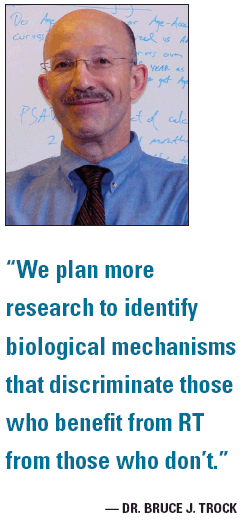Salvage RT boosts disease-free survival in prostate ca
Treatment inside a 2-year window and a PSA doubling time of less than 6 months may be the key factors for optimizing salvage radiotherapy results for recurrent prostate cancer, according to investigators from the Brady Urological Institute at Johns Hopkins School of Medicine in Baltimore.

Treatment inside a 2-year window and a PSA doubling time of less than 6 months may be the key factors for optimizing salvage radiotherapy results for recurrent prostate cancer, according to investigators from the Brady Urological Institute at Johns Hopkins School of Medicine in Baltimore. Their preliminary results offer evidence that salvage radiotherapy can improve prostate-cancer-specific survival after radical prostatectomy.
In their paper (JAMA 299:2760-2769, 2008), Bruce J. Trock, PhD, and colleagues pointed to previous trials showing that adjuvant radiotherapy improves biochemical relapse-free survival and clinical recurrence-free survival but not overall survival. These results, they wrote, “have sparked debate as to whether all patients with pT3 disease who undergo prostatectomy should receive immediate adjuvant treatment, or whether close surveillance with salvage treatment provided early upon PSA relapse can provide a similar benefit and avoid overtreating men who do not progress.”
Dr. Trock’s co-authors are Misop Han, MD, Stephen J. Freedland, MD, Elizabeth B. Humphreys, Theodore L. DeWeese, MD, Alan W. Partin, MD, PhD, and Patrick C. Walsh, MD.
The current retrospective study included 635 men who developed recurrent disease (biochemical and/or local) after radical prostatectomy performed from 1982 to 2004.
A single PSA measurement of 0.2 ng/mL or higher was the criterion for biochemical recurrence.
Of the 635 men, 397 received no salvage therapy, 160 had radiotherapy alone (66.5 Gy median dose), and 78 received salvage radiotherapy (67.2 Gy median dose) plus hormonal therapy.

The median follow-up was 6 years from a diagnosis of recurrence and 9 years from prostatectomy.
Survival results
During follow-up, 116 men (18%) died from prostate cancer: 89 (22%) who received no salvage therapy; 18 (11%) who received salvage radiotherapy alone; and 9 (12%) who received salvage radiotherapy plus hormonal therapy.
Prostate-cancer-specific survival was significantly higher in the salvage radiotherapy groups (see Table 1 on p. 36). In a multivariate model, salvage radiotherapy alone was

associated with a more than threefold decrease in prostate-cancer-specific mortality, relative to men who had no salvage therapy (HR 0.32, P < .001).
The benefit was primarily limited to the 166 men (26%) who had a PSA doubling time of less than 6 months and who received treatment within 2 years of a PSA increase. Among these men, salvage radiotherapy alone and with hormonal therapy was associated with a 75% reduction in risk of prostate-cancer-specific mortality, they wrote.
In contrast, salvage radiotherapy begun 2 or more years after recurrence did not significantly increase prostate-cancer-specific survival regardless of PSA doubling time.
The authors also reported that prostate-cancer-specific survival was significantly increased when radiotherapy was started while the PSA level was 2 ng/mL or lower.
Dr. Trock told ONI that the improvement in survival was the same for salvage radiotherapy with or without added hormone therapy, although he cautioned that the number of patients who received both treatment regimens was relatively small (78 men).
While the study strongly indicated that men who benefit from salvage radiotherapy must meet both criteria-PSA doubling criteria time of 6 months and treatment within 2 years-follow-up time beyond 6 years may lead to a different outcome, said Dr. Trock, who is the director of the Division of Epidemiology at the Brady Urological Institute.
Dr. Trock’s group will continue to track this cohort and add more patients.
“We plan more research to try to identify biological mechanisms that discriminate those who benefit from RT from those who don’t,” he said.
Prolaris in Practice: Guiding ADT Benefits, Clinical Application, and Expert Insights From ACRO 2025
April 15th 2025Steven E. Finkelstein, MD, DABR, FACRO discuses how Prolaris distinguishes itself from other genomic biomarker platforms by providing uniquely actionable clinical information that quantifies the absolute benefit of androgen deprivation therapy when added to radiation therapy, offering clinicians a more precise tool for personalizing prostate cancer treatment strategies.